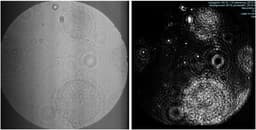| Data File(s) | Type | Description | Action |
|---|---|---|---|
Phaeocystis_counts.csv (1.65 MB) | Comma Separated Values (.csv) | Primary data file for dataset ID 683038 | |
| Supplemental File(s) | Type | Description | Action |
Fig1_hologram_phaeocystis_colonies.jpg (63.47 KB)  | JPEG Image (.jpg) | Four Phaeocystis antarctica colonies in a single unreconstructed hologram (a), and after reconstruction of one colony (b). The image volume of an individual hologram is 1.8 ml, but the reconstruction can only visualize a specific image plane within that volume. We concluded that Phaeocystis colonies were sufficiently distinguishable and unique that unreconstructed images could be used for quantification. Poor reconstruction of Phaeocystis colonies makes exact size determination unreliable but colony diameters in field collections in the Ross Sea range from approximately 10 to 400 μm (Mathot et al., 2000). |
Files
Type: Comma Separated Values (.csv)
Description: Primary data file for dataset ID 683038
Supplemental Files
Type: JPEG Image (.jpg)
Description: Four Phaeocystis antarctica colonies in a single unreconstructed hologram (a), and after reconstruction of one colony (b). The image volume of an individual hologram is 1.8 ml, but the reconstruction can only visualize a specific image plane within that volume. We concluded that Phaeocystis colonies were sufficiently distinguishable and unique that unreconstructed images could be used for quantification. Poor reconstruction of Phaeocystis colonies makes exact size determination unreliable but colony diameters in field collections in the Ross Sea range from approximately 10 to 400 μm (Mathot et al., 2000).

